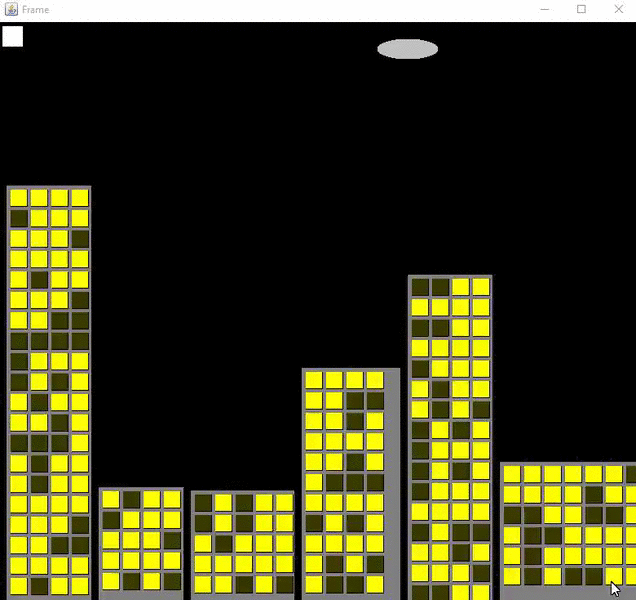Ok so I am very new to Java Swing and a beginner in Java in general. My current problem is I have designed a "cityscape". I am working on a UFO flying around, but my randomly generated buildings continue to get regenerated. I am wondering if there is a way to save my instance of buildings to an ArrayList as I have attempted, and paint that selection from that list each time paint is called. I tried what I thought of and I believe it just crashed it when run, because it didn't even open a JFrame and instead produced errors upon errors. Here is what I have:
CityScape class (the main class):
import java.awt.*;
import javax.swing.*;
public class CityScape extends JPanel
{
Buildings a = new Buildings ();
UFO b = new UFO();
@Override
public void paint (Graphics g)
{
//RememberBuildings.buildingList.get(1).paint(g);
a.paint(g);
b.paint(g);
}
public void move()
{
b.move();
}
public static void main(String[] args) throws InterruptedException
{
JFrame frame = new JFrame("Frame");
CityScape jpe = new CityScape();
frame.add(jpe);
frame.setSize(800, 750);
frame.setBackground(Color.BLACK);
frame.setLocationRelativeTo(null);
frame.setVisible(true);
frame.setDefaultCloseOperation(JFrame.EXIT_ON_CLOSE);
System.out.println(frame.getContentPane().getSize());
while (true)
{
jpe.move(); //Updates the coordinates
jpe.repaint(); //Calls the paint method
Thread.sleep(10); //Pauses for a moment
}
}
}
Buildings class (the class that generates the buildings):
import java.awt.*;
public class Buildings
{
private int maxX = 784;
private int maxY = 712;
private int width = (int)(Math.random()*100+100);
private int height = (int)(Math.random()*350+100);
private int rows = Math.round((height)/25);
private int columns = Math.round(width/25);
public void addBuilding()
{
RememberBuildings.addBuilding();
}
public void paint(Graphics g)
{
Graphics2D g2d = (Graphics2D) g;
Color transYellow = new Color (255, 255, 0, 59);
g2d.setColor(Color.BLACK);
g2d.fillRect(0, 0, maxX, maxY);
g2d.setColor(Color.WHITE);
g2d.fillRect(5, 5, 25, 25);
int a = 0;
for (int i =10; i<634; i+=(a+10))//buildings
{
g2d.setColor(Color.GRAY);
g2d.drawRect(i, maxY-height, width, height);
g2d.fillRect(i, maxY-height, width, height);
rows = Math.round((height)/25);
columns = Math.round(width/25);
for (int j = 1; j<=columns; j++)//windows
{
for (int k = 1; k<=rows; k++)
{
g2d.setColor(Color.BLACK);
g2d.drawRect(i+5*j+20*(j-1), (maxY-height)+5*k+20*(k-1), 20, 20);
if (Math.random()<0.7)
{
g2d.setColor(Color.YELLOW);
g2d.fillRect(i+5*j+20*(j-1), (maxY-height)+5*k+20*(k-1), 20, 20);
}
else
{
g2d.setColor(Color.BLACK);
g2d.fillRect(i+5*j+20*(j-1), (maxY-height)+5*k+20*(k-1), 20, 20);
g2d.setColor(transYellow);
g2d.fillRect(i+5*j+20*(j-1), (maxY-height)+5*k+20*(k-1), 20, 20);
}
}
}
addBuilding();
a = width;
height = (int)(Math.random()*462+100);
width = (int)(Math.random()*100+100);
}
}
}
RememberBuildings class (the point of this is to add an instance to an ArrayList):
import java.util.*;
public class RememberBuildings
{
public static ArrayList<Buildings> buildingList = new ArrayList<Buildings>();
public static void addBuilding()
{
buildingList.add(new Buildings());
}
}
And finally my UFO class (creates the UFO flying by):
import java.awt.*;
import javax.swing.*;
public class UFO extends JPanel
{
private int x = 20; //x and y coordinates of the ball
private int y = 20;
private int xa = 1;
public void move() //Increase both the x and y coordinates
{
if (x + xa < 0) {
xa = 1;
}
if (x + xa > 784-75)
{
xa = -1;
}
x = x + xa;
}
public void paint(Graphics g)
{
super.paint(g); //Clears the panel, for a fresh start
Graphics2D g2d = (Graphics2D) g;
g2d.setColor(Color.LIGHT_GRAY);
g2d.fillOval(x,y,75,25); //Draw the ball at the desired point
}
}

So, every time
Buildings#paintis called, it regenerates all the builds, which is done randomly.There's two ways you might be able to solve this, which you use will depend on what you want to achieve. You could render the buildings directly to a
BufferedImageand simply paint that on each paint cycle or you could cache the information you need in order to re-create the buildings.The
BufferedImageapproach is quicker, but can't be animated, so if you want to animate the buildings in some way (make the lights flicker), you will need to build up a series of information which allows you to simply repaint them.I'm going for the second, as you've asked about painting assets from a
ArrayList.I started by translating your "paint" code into a single concept of a virtual building, which has also has information about it's own lights.
This allows you to generate the primary parameters for the
Buildingand simple cache the results and when needed, simply paint it.For example...
I also changed your
UFOclass so it no longer extends fromJPanel, as it just doesn't need to and is probably the primary cause of confusion with your painting.I then updated your
paintmethod in yourCityScapeto usepaintComponentinstead...As a runnable example...
A few things here:
What You've Got:
The Structure you've got going is as follows:
The issue here is that your Building class's paint method continually draws multiple newly randomized buildings instead of a set building that retains its structure.
My Suggestion:
There are plenty of solutions to this issue and different ways to implement each solution, but my recommendation is to remodel your Building class in an OOP fashion, meaning that it would represent 1 single building (truer to the name of the class). This would contain a constructor that initializes all of the randomized dimensions of that single building once and draws that single building on the jpanel. Then you would need to keep an array or list of some sort in the cityscape that contains buildings that are part of the cityscape, eliminating the need for a "RememberBuildings" class. so roughly:
Everything else should be much the same.
Good Luck !
paint, usepaintComponentinstead. Always call thesuperpaint method before you do any custom painting to ensure that the paint chain is maintained. See Painting in AWT and Swing and Performing Custom Painting for more detailsTimerinstead of awhile (true)loop andThread.sleep. See How to use Swing Timers for more details.